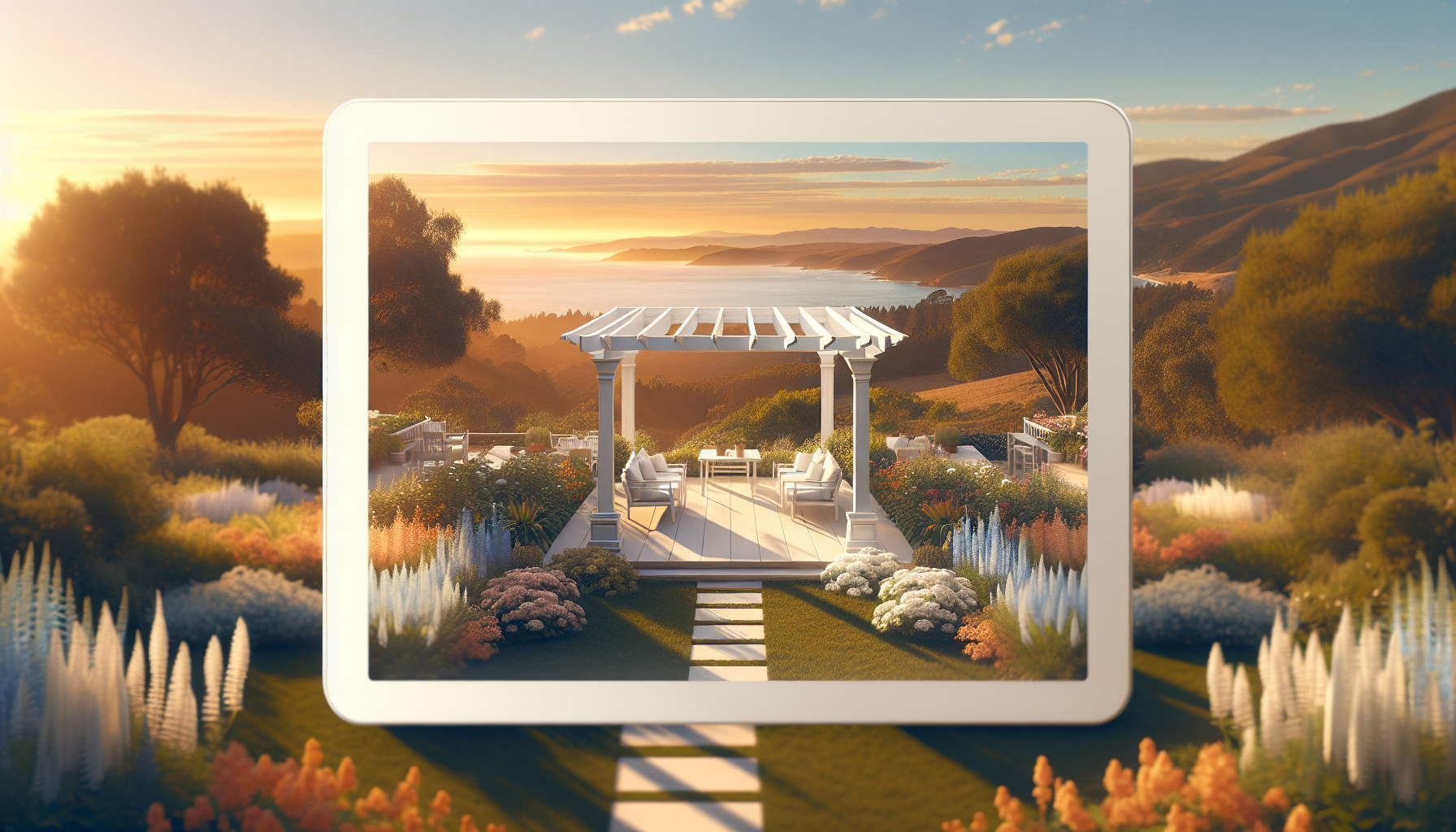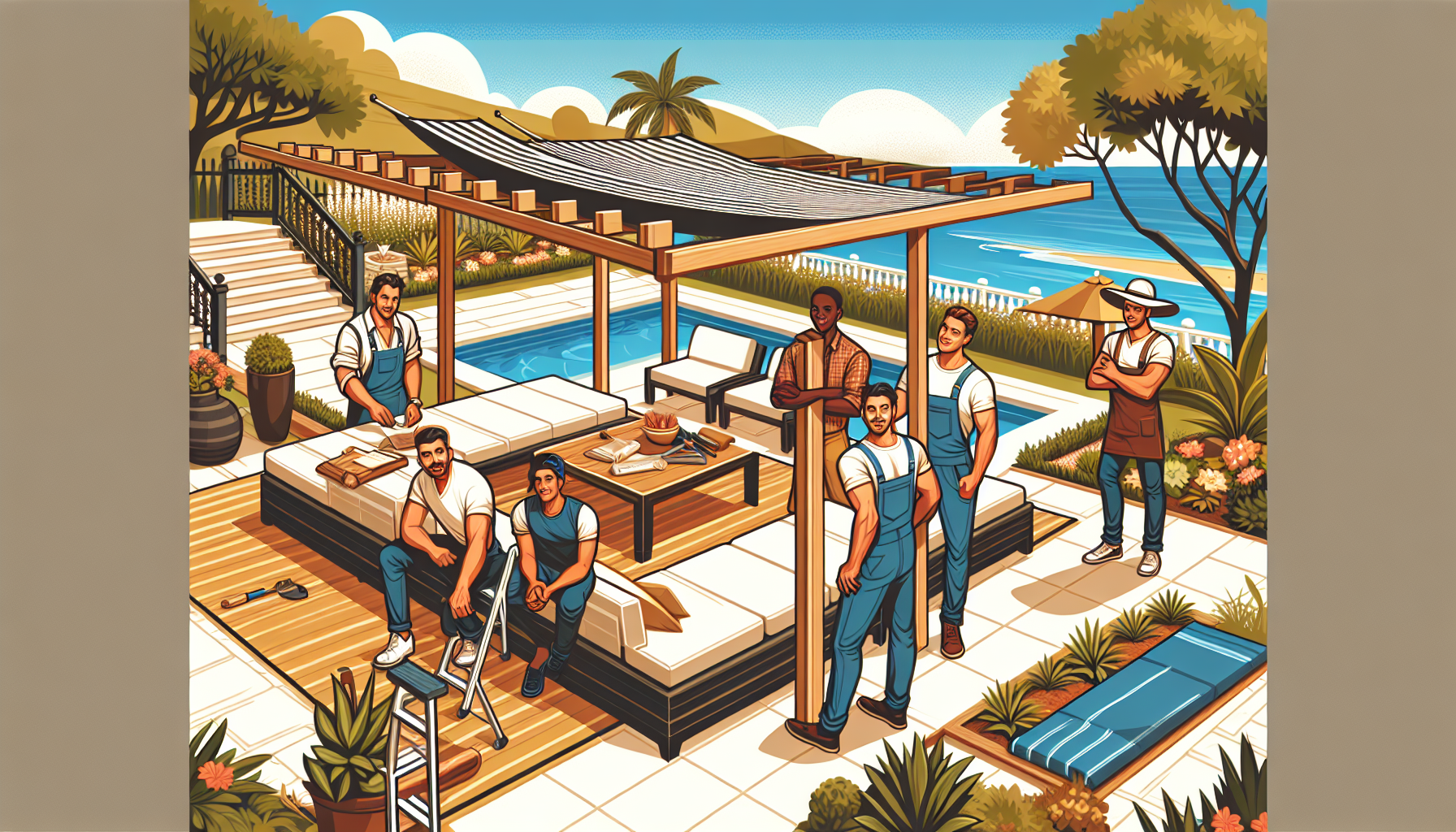Understanding the Basics of Pergola Structures
A pergola is an outdoor structure that can transform how you think about your outdoor space. Pergolas are typically made of vertical posts or pillars that support cross-beams and a sturdy open lattice, often upon which woody vines are trained. This design allows for a balance of shade and sunlight, providing a semi-open area that blends the comforts of the indoors with the natural beauty of the outside world. As we delve into the basics of pergola structures, we will explore their design, function, and the myriad ways they can enhance your outdoors.
Design Considerations
Material choices are a core element in pergola design. The most common materials include wood, vinyl, aluminum, and fiberglass. With its natural aesthetic, wood has been the traditional choice for pergolas and can be painted or stained to match any design vision. However, wood requires regular maintenance to prevent weather damage and might not be ideal for all climates. Alternatively, vinyl pergolas offer durability and minimal maintenance but may lack the unique character of their wooden counterparts. Aluminum and fiberglass options strike a balance by offering longevity and a modern look, with the added benefit of being lightweight and resistant to pests.
</,p>
Functional Aspects
The purpose of a pergola goes beyond mere aesthetics. Shade is a primary function, providing relief from direct sunlight while allowing light to filter through, creating an inviting outdoor ambiance. The framework of a pergola is often used as a foundation for climbing plants and vines, bringing a touch of nature into your outdoor living area and enhancing privacy. The structure can define spaces within a garden, carving out tranquil spots for dining, conversation, or peaceful relaxation. Additionally, pergolas can be equipped with drapes or canopies for added sun protection and privacy, giving you the flexibility to adjust the level of exposure as desired.
Varieties and Customizations
Pergolas come in various shapes and sizes, allowing them to fit into different landscapes and architectural styles. Freestanding pergolas are highly versatile and can be installed almost anywhere in your yard, creating a focal point or a secluded retreat. On the other hand, attached pergolas are connected to your home, providing an elegant transition between indoor and outdoor spaces. Customization doesn’t stop at the structure’s placement; from choosing materials and colors to including decorative elements like corbels or pendants, pergolas can be tailored to reflect the homeowner’s tastes and complement their home’s style.
Different Types of Pergola Structures for Your Garden
A pergola is an excellent choice when planning to enhance your garden with an architectural feature. This simple structure not only adds beauty to your outdoor space but also provides an area of shade and relaxation. In considering a pergola for your garden, it’s important to explore the different types of pergola structures available to find the one that best suits your landscape and lifestyle.
Traditional Wooden Pergolas
Wooden pergolas are perhaps the most classic and familiar style. Constructed from materials such as cedar, redwood, or pressure-treated pine, they blend naturally with the outdoors. The traditional wooden pergola often features a lattice roof that provides dappled light and a sturdy frame for climbing plants. Over time, the greenery that winds its way up and over the beams can enhance these structures, creating an inviting natural canopy.
Vinyl and Aluminum Pergolas
For those seeking low maintenance and longevity, vinyl and aluminum pergolas are compelling options. Vinyl pergolas resist weathering, do not require painting, and maintain a crisp, clean appearance for many years. Aluminum pergolas offer similar benefits, with the advantage of being exceptionally lightweight and corrosion-resistant. These materials provide modern and sleek designs, with various customization options, such as color and finish, to match any garden aesthetic.
Freestanding vs. Attached Pergolas
Pergola structures can also be categorized by their placement relative to other structures. Freestanding pergolas are standalone features located anywhere in your garden to create a focal point or intimate gathering space. In contrast, attached pergolas are secured to existing buildings, such as a house or garage, which extends the living space and creates a seamless transition from indoors to outdoors. Both options can dramatically enhance the functionality and enjoyment of your outdoor area, allowing for versatility in design and use.
The Advantages of Adding a Pergola Structure to Your Outdoor Space
Creating an aesthetically pleasing outdoor haven is a goal for many homeowners, and one elegant and versatile structure that can significantly enhance a backyard’s appeal is a pergola. These open-framed structures add a distinct visual element to your garden or patio while serving multiple functional benefits. Pergolas bring a new level of sophistication, seamlessly blending the comforts of indoor living with the natural beauty of the outdoors.
One of the primary advantages of including a pergola in your outdoor space is increased livability. This elegant addition creates a designated area for leisure activities, such as dining al fresco or lounging with a book. This designated area allows you to enjoy your outdoor space more throughout the year, effectively extending your living space into the outdoors. Moreover, it defines the area without enclosing it, preserving that open-air feeling while providing structure and organization to your outdoor design.
Enhanced Comfort and Entertainment
Pergolas are ideal for those who love to entertain outdoors. Not only do they provide a charming centerpiece for garden parties and barbecues, but they can also be equipped with lights, sound systems, or fans, enhancing the ambiance and comfort of your guests. Additionally, by adding curtains or drapes, you can achieve a degree of privacy and shade, protecting you and your company from the elements, whether the intense midday sun or a light summer drizzle.
Increased Property Value and Curb Appeal
Integrating a pergola into your landscape design adds enjoyment for current occupants and can increase your home’s overall market appeal and value. Such structures often become a talking point for potential buyers who can envision themselves enjoying the outdoor space. The character and charm that a pergola adds to a property can set it apart from others on the market, making it more attractive to those looking for unique outdoor features.
Choosing the Right Materials for Your Pergola Structure
When planning for a pergola, selecting materials becomes paramount to ensure durability, aesthetic appeal, and maintenance levels that suit your lifestyle. The type of material you choose will significantly influence the pergola’s longevity, its resistance to weathering, and how well it blends with your existing outdoor environment. Wood, metal, vinyl, and fiberglass are some popular choices, each with distinct advantages and considerations.
Wooden Pergolas
Wood is a classic choice for pergola structures, offering a natural and organic look that can be easily customized with stains and paints. Among the variety of woods available, ceded, redwood, and pressure-treated pine are often favored for their resistance to rot, decay, and insects, which is crucial for outdoor longevity. When opting for a wooden pergola, it’s essential to consider the maintenance required to keep the wood in good condition, including regular staining or sealing to prevent weather-related damage.
Metal Pergolas
Metal pergolas, often fabricated from aluminum or wrought iron, provide a modern twist on the traditional pergola design. Aluminum pergolas are lightweight, rustproof, and can be powder-coated for additional protection, making them a low-maintenance, durable option. Wrought iron, on the other hand, offers a sturdier frame but requires anti-rust treatment and consistent upkeep to maintain its appearance. Metal pergolas can withstand harsh weather conditions and can be designed with intricate patterns for an elegant touch.
Vinyl and Fiberglass Pergolas
Vinyl pergolas are gaining popularity due to their affordability and minimal upkeep. They resist moisture, which prevents rotting and corrosion, and their non-porous surfaces make them easy to clean. Vinyl structures are available in various styles and colors, providing flexibility in design without the need for painting. Fiberglass pergolas present another low-maintenance alternative with their robust construction. They are capable of spanning long distances without the need for additional support, offering a sleek and modern look without compromising strength.
Each material presents unique benefits and challenges, and your choice should reflect the aesthetics of your home, your personal preference for maintenance, and the climate in which the pergola will exist. Budget is also a consideration, as the cost of materials can vary widely. Finding the right balance between these factors is key to creating a pergola that enhances your outdoor space for years.
Should You Build Your Own Pergola Structure or Hire Professionals?
When adding a pergola to your outdoor space, homeowners are often caught in a dilemma: to embark on a DIY project or to call in the professionals. Both approaches have merits, but several factors must be taken into account. Building your pergola can be a rewarding experience, offering a sense of accomplishment and potential savings. However, not everyone has the necessary skills, tools, or time to commit to constructing a sturdy and aesthetically pleasing structure. Before making a decision, it’s important to consider the complexity of the design, the materials needed, and your expertise in construction and design.
DIY Pergola Building is an option for those with a level of proficiency in carpentry and a well-rounded set of tools. It is an opportunity to tailor the design to your preferences and specifications. However, you might encounter a series of challenges without the proper knowledge. Misjudging material durability, inaccuracies in cutting and assembling, and overlooking structural integrity can result in a neither safe nor enduring pergola. Furthermore, a DIY approach often lacks the warranty and assurance that professional construction offers, which could lead to additional expenses if repairs or rebuilds are needed.
In contrast, hiring professionals comes with the guarantee of experience and craftsmanship. Trained professionals can navigate local building codes and permits that many DIY enthusiasts might overlook, ensuring that your pergola is compliant and safe. They often have access to higher quality materials at wholesale prices and can complete the structure more quickly than non-professionals. The professional route may come with a higher upfront cost, but it often provides greater peace of mind with warranties for materials and labor.
Moreover, professional builders can provide expert advice on the best location, size, and design for your pergola, which can enhance the overall functionality and integration with your landscape. It’s also worth considering the value of time; a project that could take several weekends to complete can be finished by a professional crew in a fraction of that time. When you factor in the potential need for costly tools and the value of your time, hiring a professional might be the safer choice and the more economical one in the long run.




